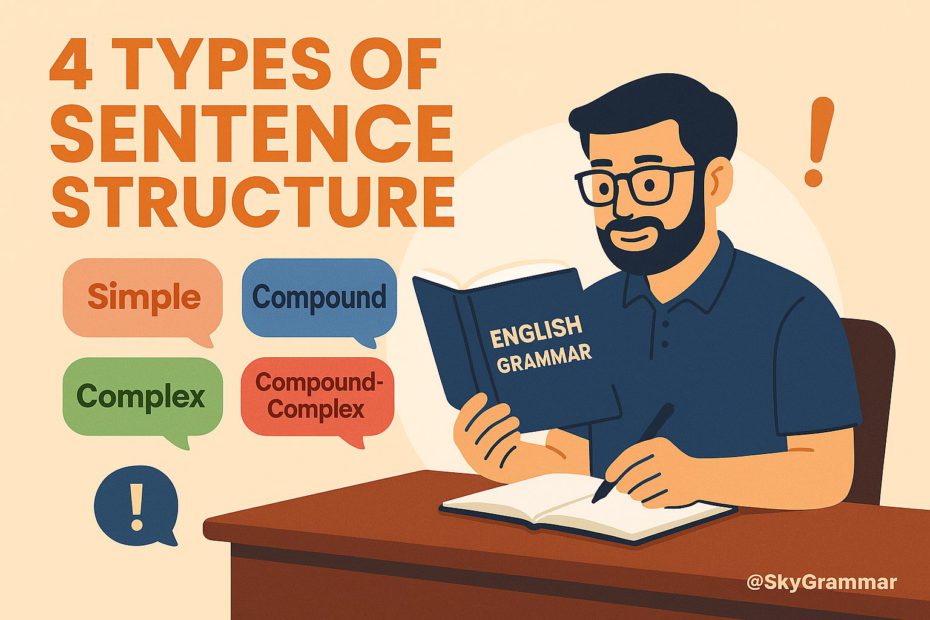In English grammar, how a sentence is structured plays a crucial role in how clearly and effectively your ideas are communicated. While vocabulary and grammar are essential, sentence structure determines the rhythm, variety, and readability of your writing. Whether you’re writing an academic essay, a blog post, or just trying to improve everyday communication, understanding the four types of sentence structure can transform your writing style.
In this blog post, we’ll break down the four types of sentence structure, explain how they work, provide examples, and share tips for using them effectively.
🧱 What Is Sentence Structure?
Sentence structure describes how a sentence is formed, especially in terms of how its clauses are arranged. A clause is a unit of language that includes a subject and a verb. There are two types of clauses:
- Independent clause – expresses a complete thought and can stand alone as a sentence.
- Dependent clause – cannot stand alone and depends on the main clause to make sense.
By combining clauses in different ways, we get four distinct sentence structures in English.
1. Simple Sentence
✅ Definition:
A simple sentence is made up of just one independent clause. It includes a subject and a verb, and it communicates a complete idea on its own. Even though it’s “simple,” it can include compound elements like compound subjects or verbs.
📌 Examples:
- The sun set behind the mountains.
- Sarah and Liam went to the park.
- Dogs bark.
🎯 Why Use Simple Sentences?
Simple sentences are clear and direct. They’re ideal for making bold statements, delivering key points, or improving readability. Overusing them, however, can make writing feel choppy.
✍️ Pro Tip:
Use simple sentences to emphasize important ideas or when introducing new information.
2. Compound Sentence
✅ Definition:
A compound sentence combines two or more independent clauses using a coordinating conjunction (such as and, but, or, so, for, nor, yet) or a semicolon.
📌 Examples:
- I planned to take a walk; however, the rain began unexpectedly.
- She studied all night; she passed the exam.
- You can have coffee, or you can have tea.
🎯 Why Use Compound Sentences?
They help connect related ideas and show relationships like contrast or cause-and-effect. Compound sentences create variety and improve the flow of writing.
✍️ Pro Tip:
When joining two independent clauses with a coordinating conjunction, a comma should be placed before the conjunction.
3. Complex Sentence
✅ Definition:
A complex sentence includes one independent clause and at least one dependent clause. Such sentences are connected using subordinating conjunctions like because, although, since, while, if, unless, when, before, and after.
📌 Examples:
- Because I was late, I missed the meeting.
- She smiled when she saw the puppy.
- Although he was tired, he continued working.
🎯 Why Use Complex Sentences?
They help convey more detailed or nuanced information by showing time, reason, contrast, or condition. They also help in combining ideas to reduce repetition.
✍️ Pro Tip:
Place a comma after a dependent clause if it begins the sentence. However, if the independent clause comes first, a comma is generally not required.
- If it rains, we’ll cancel the picnic.
- We’ll cancel the picnic if it rains.
4. Compound-Complex Sentence
✅ Definition:
A compound-complex sentence has at least two independent clauses and one or more dependent clauses. It combines the structure of both compound and complex sentences.
📌 Examples:
- Although it was raining, I went for a run, and I felt refreshed afterward.
- She likes the painting because it’s unique, but her brother disagrees.
- When the show ended, we left the theater, and we stopped for dessert.
🎯 Why Use Compound-Complex Sentences?
They allow you to express complex relationships and multiple ideas in a single sentence. They are excellent for advanced writing and academic contexts.
✍️ Pro Tip:
Be careful with punctuation. Use commas to separate clauses properly, especially when the sentence begins with a dependent clause.
✨ Why Sentence Structure Matters
Understanding and using different sentence structures allows you to:
- Enhance readability by avoiding repetitive patterns.
- You can create emphasis by deliberately selecting specific sentence types and varying sentence lengths.
- They help illustrate the relationship between ideas, such as contrast, cause and effect, or the sequence of events.
- Maintain reader interest with variety in sentence flow.
Too many simple sentences can feel abrupt. Too many complex or compound-complex sentences may overwhelm the reader. The key is to balance sentence types according to the tone, purpose, and audience of your writing.
🧠 Quick Review Chart
| Sentence Type | Clauses Included | Example |
|---|---|---|
| Simple | 1 Independent clause | “The children laughed.” |
| Compound | 2+ Independent clauses | “He studied diligently, and he successfully passed the exam.” |
| Complex | 1 Independent + 1+ Dependent clauses | “She cried because she failed the test.” |
| Compound-Complex | 2+ Independent + 1+ Dependent clauses | “Although she was tired, she cooked dinner, and he helped.” |
💡 Final Tips for Mastering Sentence Structure
- Vary your sentence types within paragraphs to improve rhythm and flow.
- Read your writing aloud to catch monotonous or overly complex structures.
- Enhance sentence fluency by merging shorter sentences into longer, more complex structures.
- Keep clarity in mind. Don’t sacrifice understanding for complexity.
🎓 Conclusion
Mastering the four types of sentence structure—simple, compound, complex, and compound-complex—is essential for developing strong, effective writing. Every sentence type serves a unique function in expressing thoughts and conveying meaning effectively. When used purposefully and thoughtfully, they bring clarity, style, and strength to your language.
By recognizing these structures and practicing them regularly, you’ll become a more versatile and confident writer—whether you’re crafting stories, emails, reports, or academic essays.

